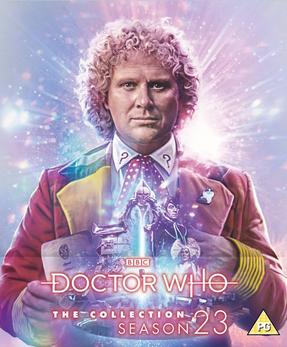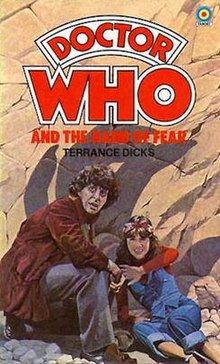Time and the Rani is the first serial of the 24th season of the British science fiction television series Doctor Who, which was first broadcast in four weekly parts from 7 to 28 September 1987. It was the first to feature Sylvester McCoy as the Seventh Doctor.

The twenty-third season of British science fiction television series Doctor Who, known collectively as The Trial of a Time Lord, aired in weekly episodes from 6 September to 6 December 1986. It contained four adventures: The Mysterious Planet, Mindwarp, Terror of the Vervoids and The Ultimate Foe; the season also marked the final regular appearance of Colin Baker as the Sixth Doctor.

The Daleks is the second serial in the British science fiction television series Doctor Who, which was first broadcast on BBC TV in seven weekly parts from 21 December 1963 to 1 February 1964. Written by Terry Nation and directed by Christopher Barry and Richard Martin, this story marks the first appearance of the show's most popular villains, the Daleks, and the recurring Skaro people, the Thals. In the serial, the First Doctor, his granddaughter Susan Foreman, and her teachers Ian Chesterton and Barbara Wright land in an alien jungle and are captured by the Daleks, a race of mutated creatures who survive off the radiation that remains in the atmosphere after a nuclear war with their enemies. As the group attempt to escape the Daleks, they discover more about the planet and the ensuing war, and attempt to broker a peace.

The Edge of Destruction is the third serial of the British science fiction television series Doctor Who. It was written by David Whitaker, and first broadcast on BBC TV in two weekly parts on 8 February and 15 February 1964. The first episode was directed by Richard Martin, while Frank Cox directed the second. In the story, the Doctor, his granddaughter Susan, and her teachers Ian Chesterton and Barbara Wright are in the Doctor's time and space machine the TARDIS when it appears to be taken over by an outside force. The travellers begin acting strangely and turn against each other.
Planet of the Daleks is the fourth serial of the tenth season of the British science fiction television series Doctor Who, which was first broadcast in six weekly parts on BBC1 from 7 April to 12 May 1973.
The Deadly Assassin is the third serial of the 14th season of the British science fiction television programme Doctor Who, which was first broadcast in four weekly parts on BBC1 from 30 October to 20 November 1976. It is the first serial in which the Doctor is featured without a companion, and the only such story for the classic era.
Pyramids of Mars is the third serial of the 13th season of the British science fiction television series Doctor Who. Written by Robert Holmes and Lewis Greifer under the pseudonym of "Stephen Harris" and directed by Paddy Russell, the serial was first broadcast in four weekly parts on BBC1 from 25 October to 15 November 1975.
Robot is the first serial of the 12th season in the British science fiction television series Doctor Who, which was first broadcast in four weekly parts on BBC1 from 28 December 1974 to 18 January 1975. It was the first full serial to feature Tom Baker as the Fourth Doctor, as well as Ian Marter as new companion Harry Sullivan. The serial brought a full end to the Pertwee era, as it was the final story with the production team of Barry Letts and script editor Terrance Dicks. It was also the final regular appearance of UNIT, who had become regulars starting with the first Jon Pertwee serial Spearhead From Space.
The Curse of Fenric is the third serial of the 26th season of the British science-fiction television series Doctor Who, which was first broadcast in four weekly parts on BBC1 from 25 October to 15 November 1989.
Planet of the Spiders is the fifth and final serial of the 11th season of the British science fiction television series Doctor Who, which was first broadcast in six weekly parts on BBC1 from 4 May to 8 June 1974. It was Jon Pertwee's final regular appearance as the Third Doctor, the last regular appearance of Mike Yates, and marks the first, uncredited appearance of Tom Baker as the Fourth Doctor. This serial introduces the term "regenerate" to explain the Doctor's transformation into another appearance.
The Masque of Mandragora is the first serial of the 14th season of the British science fiction television series Doctor Who, which was first broadcast in four weekly parts on BBC1 from 4 to 25 September 1976.
The Ribos Operation is the first serial of the 16th season of the British science fiction television series Doctor Who, which was first broadcast in four weekly parts on BBC1 from 2 to 23 September 1978. This serial introduces Mary Tamm as the companion Romana.
The Armageddon Factor is the sixth and final serial of the 16th season of the British science fiction television series Doctor Who, which was first broadcast in six weekly parts on BBC1 from 20 January to 24 February 1979. It was the last to feature Mary Tamm as Romana.
The Visitation is the fourth serial of the 19th season of the British science fiction television series Doctor Who, which was first broadcast in four twice-weekly parts on BBC1 from 15 to 23 February 1982.
The Brain of Morbius is the fifth serial of the 13th season of the British science fiction television series Doctor Who, which was first broadcast in four weekly parts on BBC1 from 3 to 24 January 1976. The screenwriter credit is given to Robin Bland, a pseudonym for writer and former script editor Terrance Dicks, whose original script had been heavily rewritten by his successor as script editor, Robert Holmes. It is the first serial to feature the Sisterhood of Karn.
Planet of Evil is the second serial of the 13th season of the British science fiction television series Doctor Who. It was first broadcast in four weekly parts on BBC1 from 27 September to 18 October 1975.
Revenge of the Cybermen is the fifth and final serial of the 12th season of the British science fiction television series Doctor Who, which was first broadcast in four weekly parts on BBC1 from 19 April to 10 May 1975. It was the first to feature the Cybermen since The Invasion (1968) and the last until Earthshock (1982).
Destiny of the Daleks is the first serial of the 17th season of the British science fiction television series Doctor Who, which was first broadcast in four weekly parts on BBC1 from 1 September to 22 September 1979. The story introduces Lalla Ward as the newly regenerated Romana.
Death to the Daleks is the third serial of the 11th season of the British science fiction television series Doctor Who, which was first broadcast in four weekly parts on BBC1 from 23 February to 16 March 1974.
Colony in Space is the fourth serial of the eighth season of the British science fiction television series Doctor Who, which was first broadcast in six weekly parts on BBC1 from 10 April to 15 May 1971.



